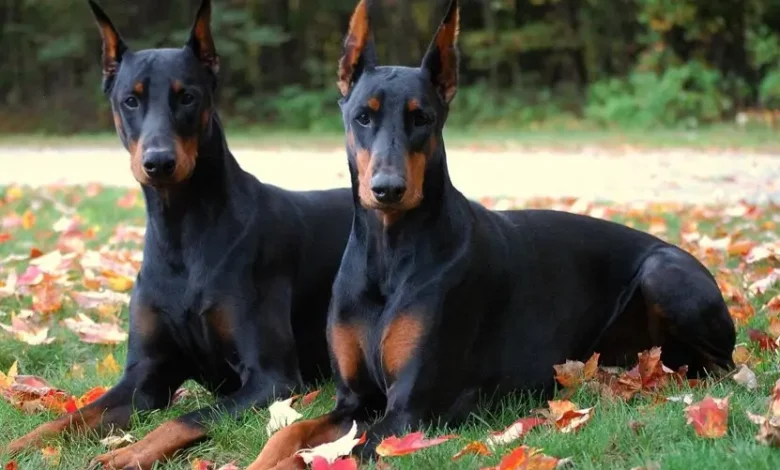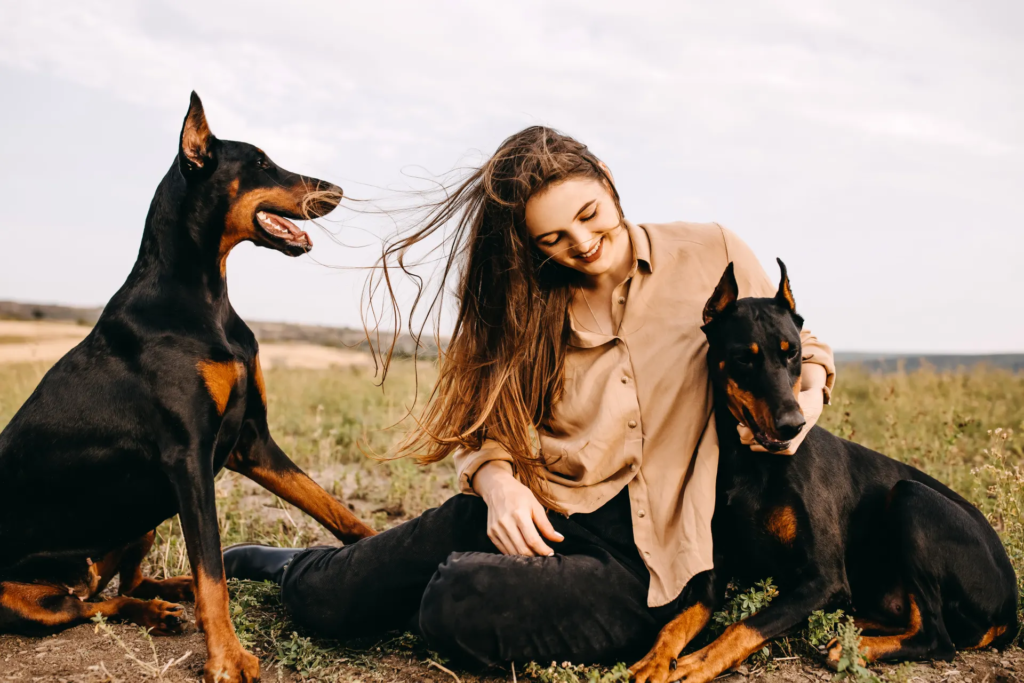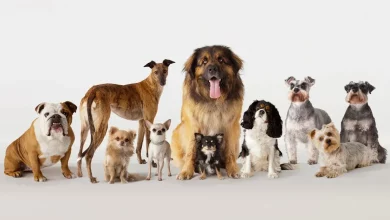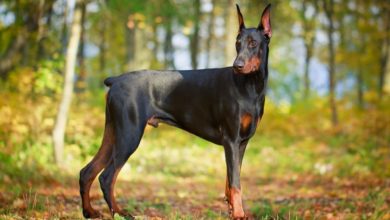Doberman Pinschers Are Highly Regarded

Doberman Pinschers are among the most recognizable dog breeds, known for their sleek, powerful appearance and exceptional intelligence.
This breed has won the hearts of many due to its loyalty, protectiveness, and versatility. Whether as family pets, working dogs, or competitors in dog sports, Dobermans excel in various roles, making them highly regarded around the world.
History of Doberman Pinschers

The Doberman Pinscher originated in the late 19th century, thanks to Karl Friedrich Louis Dobermann, a German tax collector who wanted a loyal and protective dog to accompany him. By breeding several dog breeds, including the Rottweiler, German Pinscher, and Greyhound, he developed the Doberman Pinscher. Over time, the breed evolved, gaining popularity for its working capabilities and companionship qualities.
Physical Characteristics
General Appearance
Dobermans are medium to large-sized dogs with a sleek, muscular build. They have a regal and athletic appearance, characterized by a deep chest, strong limbs, and a straight back. Their elegant gait and alert expression contribute to their striking presence.
The Doberman Pinscher is a striking breed known for its sleek appearance and alert demeanor. Here are some key features of their general appearance:
- Body: Dobermans have a powerful, athletic build with a deep chest and well-muscled body.
- Head: Their head is wedge-shaped, with a strong jawline and a flat skull. The ears are typically cropped to stand erect.
- Eyes: Dark and expressive, the eyes convey intelligence and focus.
- Tail: Traditionally docked, the tail is short and carried high.
- Coat: Their short coat is smooth and lies close to the body, usually in black, red, blue, or fawn colors.
- Overall Impression: Dobermans exude confidence, elegance, and strength.
Size and Weight
Doberman Pinschers are large and slender dogs with short, dark coats. Here’s a breakdown of their size and weight:
- Male Doberman Pinscher:
- Weight: Between 75 and 100 pounds
- Height: Around 26 to 28 inches at the shoulder
- Female Doberman Pinscher:
- Weight: Between 60 and 90 pounds
- Height: About 24 to 26 inches at the shoulder
Keep in mind that individual variations can occur based on genetics, diet, and exercise. If you’re considering a Doberman Pinscher, understanding their potential size is essential for planning and care!
Coat and Colors
Dobermans have a short, smooth coat that comes in several colors, including black, blue, red, and fawn, usually with rust-colored markings above the eyes, on the muzzle, chest, and legs.
Doberman Pinscher’s coat and colors:
- Coat Type:
- The Doberman has a short, smooth coat that lies close to the body. It’s easy to maintain and sheds moderately.
- Their coat provides good protection against the elements.
- Color Variations:
- The Doberman comes in several recognized colors:
- Black and Rust: The most common color combination. Black covers most of the body, with rust markings on the face, chest, legs, and tail.
- Red and Rust: Similar to black and rust, but with a rich reddish-brown base coat.
- Blue and Rust: A striking blue-gray coat with rust markings.
- Fawn (Isabella) and Rust: A light tan or fawn base coat with rust accents.
- White Dobermans exist but are not recognized by major kennel clubs due to potential health issues associated with the white gene.
- The Doberman comes in several recognized colors:
- Markings:
- Rust markings appear above the eyes, on the muzzle, throat, chest, legs, and paws.
- The ideal distribution of rust markings enhances the Doberman’s appearance.
Remember that coat color and markings can vary slightly among individual dogs, but these are the standard variations you’ll find in this elegant breed!
Temperament and Personality
Intelligence and Loyalty
Dobermans are known for their high intelligence and quick learning abilities. They are incredibly loyal to their families and form strong bonds with their owners, often acting as protectors.
Here are some key traits:
- Loyal and Protective: Dobermans are fiercely loyal to their families. They form strong bonds and will protect their loved ones.
- Intelligent: These dogs are highly intelligent and eager to learn. They excel in obedience training and thrive on mental stimulation.
- Alert and Watchful: Dobermans are natural watchdogs. Their alertness makes them excellent guard dogs.
- Energetic: They have a lot of energy and need regular exercise. Daily walks, playtime, and mental challenges keep them happy.
- Affectionate: Despite their protective nature, Dobermans are affectionate with their family members. They enjoy cuddling and being close.
- Confident: Dobermans exude confidence. Their presence commands respect.
Remember that individual personalities can vary, but these general traits capture the essence of the Doberman Pinscher!
Doberman Pinschers and the Guarding Instincts
Their guarding instincts make them excellent watchdogs. They are naturally alert and will protect their territory and loved ones if they sense danger. However, this trait needs to be managed with proper training and socialization to prevent over-protectiveness.
Here are some points about their protective nature:
- Alertness: Dobermans are naturally watchful and vigilant. They quickly notice any changes in their environment.
- Territorial: They consider their home and family as their territory. They’ll defend it against perceived threats.
- Loyalty: Dobermans are fiercely loyal to their owners. They’ll stand by them in any situation.
- Fearlessness: Their courage and fearlessness make them excellent guard dogs.
Remember that proper training and socialization are essential to channel their protective instincts positively!
Doberman Pinschers : Compatibility with Families and Other Pets
Dobermans can be excellent family pets. They are affectionate and gentle with children when properly socialized. They can also get along well with other pets if introduced correctly, although their natural dominance may require careful management.
Doberman Pinschers can be great family dogs, but there are some considerations:
- Families:
- Dobermans are loyal and protective, making them excellent family companions.
- They thrive in homes with consistent routines and clear boundaries.
- Early socialization is crucial to ensure they’re comfortable around children and other family members.
- Other Pets:
- Proper introductions are essential when bringing a Doberman into a home with other pets.
- They can get along well with other dogs if introduced early and positively.
- Cats and small animals may trigger their prey drive, so supervision is necessary.
- Children:
- Dobermans are generally good with children they know.
- Teach kids how to interact respectfully with the dog to avoid any misunderstandings.
Remember that individual temperament varies, so getting to know your specific Doberman’s personality is key!
Training and Socialization
Importance of Early Training
Early training is crucial for Dobermans to develop into well-behaved adults. Their intelligence makes them highly trainable, but it also means they need mental stimulation and clear, consistent commands.
Early training is crucial for Doberman Pinschers. Here’s why:
- Socialization: Early exposure to various people, animals, and environments helps them develop confidence and adaptability.
- Obedience: Basic commands like sit, stay, and recall are essential. Consistent training builds a well-behaved companion.
- Behavioral Foundation: Early training sets the groundwork for proper behavior, reducing the risk of aggression or anxiety.
- Bonding: Training strengthens the bond between you and your Doberman.
Remember, patience and positive reinforcement go a long way!
Effective Training Methods
Positive reinforcement methods work best with Dobermans. Using rewards like treats, praise, and playtime can motivate them to learn and follow commands. Consistency and patience are key to successful training.
When it comes to training Doberman Pinschers, here are some effective methods:
- Positive Reinforcement: Use rewards like treats, praise, and playtime to reinforce desired behaviors. This encourages your Doberman to repeat those actions.
- Consistency: Be consistent in your commands and expectations. Repetition helps them learn faster.
- Socialization: Introduce your Doberman to various people, animals, and environments early on. This builds confidence and reduces anxiety.
- Basic Commands: Teach essential commands like sit, stay, come, and heel. These create a well-behaved companion.
- Crate Training: Proper crate training helps with housebreaking and provides a safe space for your dog.
Remember, patience and positive interactions go a long way in shaping a well-adjusted and obedient Doberman!
Doberman Pinschers : Socialization Tips
Expose Dobermans to various people, environments, and other animals from a young age to ensure they grow up to be well-rounded and confident. Puppy classes and regular outings can help with their socialization.
Socializing your Doberman Pinscher is essential for their well-being. Here are some tips:
- Start Early: Begin socialization when your Doberman is a puppy. Expose them to various people, animals, and environments.
- Positive Experiences: Make interactions positive. Reward good behavior with treats, praise, and playtime.
- Different Settings: Take your Doberman to different places—parks, streets, cafes—to help them feel comfortable everywhere.
- Meet People: Introduce your dog to different people, including children, so they learn to trust and feel at ease.
- Dog Friends: Arrange playdates with other friendly dogs. This helps them learn appropriate canine behavior.
Remember, gradual exposure and positive reinforcement create a confident, well-adjusted Doberman!
Exercise and Activity Levels
Daily Exercise Requirements
Dobermans are active dogs that require plenty of exercise to stay healthy and happy. Aim for at least an hour of vigorous activity each day, including walks, runs, and playtime.
Doberman Pinschers are energetic dogs that require regular exercise to stay healthy and happy. Here are some guidelines for their daily exercise:
- Physical Activity:
- Brisk Walks: Aim for at least 30 to 45 minutes of brisk walking or jogging daily.
- Playtime: Engage in active play sessions, such as fetch or tug-of-war, to keep them mentally and physically stimulated.
- Mental Stimulation:
- Training: Incorporate training sessions into their routine. Mental challenges are as important as physical exercise.
- Puzzle Toys: Use puzzle toys or treat-dispensing toys to keep their minds engaged.
- Off-Leash Time:
- Dobermans love to run and explore. If possible, provide off-leash time in a secure area.
- Variety:
- Mix up their activities—hiking, swimming, or agility training—to prevent boredom.
Remember that individual needs vary, so observe your Doberman’s energy levels and adjust their exercise accordingly!
Suitable Activities for Dobermans
They enjoy various activities such as agility training, obedience competitions, and playing fetch. Mental exercises, like puzzle toys and advanced training sessions, can also keep them stimulated.
Doberman Pinschers thrive on physical and mental stimulation. Here are some suitable activities:
Agility Training: Set up an agility course with jumps, tunnels, and weave poles. Dobermans love the challenge!
Fetch: Play fetch in a secure area. Their athleticism shines during a game of fetch.
Swimming: If your Doberman enjoys water, swimming is an excellent full-body workout.
Hiking: Take them on nature hikes. The varied terrain engages their muscles and senses.
Brain Games: Use puzzle toys, hide treats, or teach new tricks. Mental exercise is as important as physical activity.
Remember to tailor activities to your Doberman’s preferences and energy level!
Mental Stimulation
Dobermans thrive on mental challenges. Incorporating training games, scent work, and interactive toys can prevent boredom and destructive behavior.
Providing mental stimulation for your Doberman is essential to keep their intelligent minds engaged. Here are some activities to challenge them:
- Puzzle Toys: Invest in interactive toys that dispense treats or require problem-solving. These engage their minds and keep them entertained.
- Hide-and-Seek: Hide treats or toys around the house, and encourage your Doberman to find them. It’s a fun game that stimulates their senses.
- Training Sessions: Regular training not only reinforces obedience but also provides mental exercise. Teach new commands or tricks to keep their minds sharp.
- Scent Work: Set up scent trails or hide treats in different areas. Let your Doberman follow their nose—it’s mentally stimulating!
- Rotate Toys: Keep their toy collection fresh by rotating them. New textures, shapes, and challenges prevent boredom.
Remember, a mentally stimulated Doberman is a happy and well-adjusted companion!
Health and Lifespan
Common Health Issues
Like all breeds, Dobermans are prone to specific health conditions. Some common issues include hip dysplasia, heart problems, and a bleeding disorder called von Willebrand’s disease.
Doberman Pinschers are wonderful dogs, but like any breed, they can face health challenges. Here are some common issues to be aware of:
- Dilated Cardiomyopathy (DCM): A genetic heart condition where the heart enlarges and weakens. It’s often fatal.
- Von Willebrand Disease (vWD): A bleeding disorder due to low levels of clotting factor. Regular check-ups are crucial.
- Chronic Active Hepatitis (CAH): Liver inflammation that can lead to liver failure. Early detection is essential.
- Cervical Vertebral Instability (Wobbler Syndrome): A spinal issue causing weakness and unsteady gait. Consult a vet if you notice symptoms.
- Hypothyroidism: Common in fawn and blue Dobermans. Signs include lack of energy, recurrent infections, and hair loss.
- Gastric Dilatation and Volvulus Syndrome (GDV or “Bloat”): A life-threatening condition where the stomach twists. Immediate veterinary attention is crucial.
Remember, regular vet visits and attentive care can help manage these health concerns!
Preventative Care
Regular veterinary check-ups, a balanced diet, and maintaining a healthy weight can help prevent many health problems. Vaccinations, flea and tick prevention, and dental care are also essential.
To keep your Doberman Pinscher healthy and happy, consider the following preventative care measures:
- Regular Vet Visits: Schedule routine check-ups to catch any health issues early and ensure timely treatment.
- Good Nutrition: Feed a balanced diet with high-quality dog food. Consult your vet for specific dietary recommendations.
- Daily Exercise: Engage your Doberman in regular physical activities. Aim for about 90 minutes of exercise per day, including walks, jogs, and playtime.
- Stress Management: Provide a calm and secure environment. Dobermans thrive when they feel safe and relaxed.
- Proper Grooming: Brush their coat daily with a short-bristled brush or grooming mitt. Trim nails monthly and brush their teeth regularly.
Remember, a proactive approach ensures a healthy and strong companion!
Average Lifespan
The average lifespan of a Doberman Pinscher typically falls between 10 and 13 years. Regular checkups are essential, as early detection can address genetic disorders that the breed is prone to. While this is the general range, some individuals may live beyond it, reaching 14 or even 15 years with proper care and favorable genetics
Diet and Nutrition
Nutritional Needs
Dobermans need a balanced diet rich in protein, fats, vitamins, and minerals. High-quality commercial dog food formulated for large breeds can meet their nutritional requirements.
Doberman Pinschers require a balanced diet that is high in protein and fat to maintain their muscular builds and energy levels. Feeding them high-quality dog food appropriate for their age and activity level is crucial. Consider supplements like Omega-3 fatty acids and probiotics to support their digestive health. If you’re feeding dry dog food, here’s a general guideline:
- Puppy Food:
- 2-3 months: Males 1-3 cups, Females 1-2.5 cups
- 4-5 months: Males 3-6 cups, Females 2.5-5 cups
- 6-8 months: Males 4-6.5 cups, Females 3-6 cups
- 9-11 months: Males 4-7 cups, Females 3-6.5 cups
- 1-2 years: Males 4.5-8 cups, Females 4-7 cups
- Adult Food (3-6 years): Males 4-7 cups, Females 3-6.5 cups
- Senior Food (7+ years): Males 3-6 cups, Females 2.5-5 cups
Remember to adjust based on your specific Doberman’s needs and consult your veterinarian for personalized recommendations! 🐾🍽️
Recommended Diet Plans
Divide their meals into two or three portions a day to prevent bloating. Consult your vet for personalized diet recommendations based on your dog’s age, weight, and activity level.
Foods to Avoid
Avoid feeding Dobermans foods that are toxic to dogs, such as chocolate, grapes, onions, and foods high in fat. Table scraps should also be limited to prevent obesity and digestive issues.
When it comes to feeding your Doberman Pinscher, there are certain foods you should avoid to keep them healthy and safe. Here are some examples:
- Milk and Dairy: While some dairy products like cheese and yogurt are okay in moderation, avoid giving them goat milk, butter, or margarine, as they contain harmful toxins.
- Potato Leaves, Stems, and Skin: These parts of the potato can be toxic to dogs, including Dobermans.
- Grapes and Raisins: Grapes and raisins can cause kidney damage and should never be given to your Doberman.
- Coconut and Coconut Oil: While coconut is trendy for humans, it’s not suitable for dogs due to its high fat content.
- Chocolate: Chocolate contains theobromine, which is toxic to dogs. Keep it away from your furry friend.
- Peach Stems, Leaves, and Pits: Peach pits contain cyanide, which is dangerous for dogs.
Remember, a well-balanced diet and avoiding harmful foods are essential for your Doberman’s health!
Grooming and Maintenance
Doberman Pinschers are relatively low-maintenance when it comes to grooming. Here are some tips to keep your Dobie looking great:
- Brushing: Their short, hard coat sheds regularly. Weekly brushing with a rubber brush or grooming mitt will help keep it looking good and minimize shed hair around your home.
- Bathing: Experts recommend bathing every six weeks to three months. If your Doberman spends a lot of time outdoors or has a strong doggy odor, more frequent baths may be necessary. Use moisturizing or deodorizing shampoo.
- Ear Care: Clean the ears regularly to prevent wax buildup and infections.
- Nail Trimming: Trim their nails monthly, adjusting based on their activity level.
- Styling and Haircuts: Dobermans don’t need styling or haircuts for their short, athletic coat. However, some owners choose to crop their ears for functional reasons (historically related to protection and hearing advantage).
Remember, a little care goes a long way in keeping your Doberman healthy and handsome!
Coat Care
Dobermans have low grooming needs due to their short coat. Regular brushing, about once a week, can help remove loose hairs and keep their coat shiny.
Nail Trimming and Dental Care
Trim their nails regularly to prevent overgrowth and discomfort. Dental hygiene is also crucial, so brush their teeth several times a week or provide dental chews to maintain oral health.
Regular Check-Ups
Routine veterinary visits are essential for early detection and treatment of health issues. Keep up with vaccinations, parasite prevention, and annual health screenings.
Doberman Pinschers in Work and Service
Roles in Law Enforcement and Military
Dobermans have a long history of serving in law enforcement and the military. Their intelligence, trainability, and keen sense of smell make them excellent in roles like search and rescue, tracking, and detection.
Service and Therapy Dogs
Their loyal and attentive nature also makes Dobermans suitable as service and therapy dogs. They can assist individuals with disabilities, provide emotional support, and even work in hospitals and nursing homes.
Competitive Sports
Dobermans excel in various dog sports, including obedience, agility, and Schutzhund (a protection dog sport). These activities showcase their athleticism and working capabilities.
Choosing a Doberman Pinscher
When selecting a Doberman Pinscher, consider the following factors:
- American vs. European Doberman:
- American Doberman:
- Sleek, elegant show dog.
- Ideal temperament for families.
- Intelligent, loving, and in tune with emotions.
- Excels as a family companion.
- European Doberman:
- Slightly larger, more muscular.
- Suited for working roles.
- High drive and protective temperament.
- May require more exercise.
- Consider your lifestyle and preferences.
- American Doberman:
- Choosing a Puppy:
- Perform basic litter research.
- Inspect the litter visually.
- Conduct temperament tests on each puppy.
- Match personality to yours for a good fit.
- Reputable Breeder:
- Research breeders thoroughly.
- Ask questions about health, lineage, and socialization.
- Visit the breeder’s facility.
- Trustworthy breeders prioritize puppy health and well-being.
Remember, understanding the breed variations and assessing individual puppies will help you find the perfect Doberman for your family!
Finding Reputable Breeders
If you decide to purchase a Doberman, it’s crucial to find a reputable breeder who prioritizes health, temperament, and ethical breeding practices. Ask for health clearances and visit the breeder’s facilities if possible.
Adoption and Rescue Options
Adopting a Doberman from a rescue organization or shelter is another excellent option. Many Dobermans need loving homes, and adoption can be a rewarding experience.
What to Look for in a Puppy
When choosing a puppy, look for signs of good health and a friendly, confident demeanor. Avoid puppies that appear fearful or aggressive, as early temperament can be an indicator of future behavior.
When choosing a puppy, there are several important factors to consider. Let’s break it down:
- Assess Your Lifestyle:
- Financial Situation: Ensure you can afford the costs associated with dog ownership, including equipment, food, and vet fees.
- Living Space: Consider where you live—house, apartment, or condo. Puppies need space and fresh air.
- Work-Life Balance: Puppies require time and attention. If you have a busy schedule, think twice.
- Physical Health Indicators:
- Mouth: Clean teeth and healthy gums.
- Fur: Shiny, soft coat without fleas.
- Legs: Strong and sturdy, no limping.
- Bottom: Clean and dry under the tail.
- Ribs: Not visible (well-fed).
- Eyes: Clear, bright, and open.
- Genitals: No visible feces or pus.
- Energy: Bright, active, and friendly.
Remember, choosing a puppy is a long-term commitment, so make an informed decision!
Living Conditions and Environment
Ideal Home Settings
Dobermans do best in homes where they have space to move and play. They can adapt to apartment living if given enough exercise, but a house with a yard is ideal.
Adaptability to Different Environments
While they can adapt to various environments, Dobermans are sensitive to extreme temperatures. Ensure they have a comfortable, climate-controlled living space.
Safety Considerations
Ensure your home and yard are secure, as Dobermans are active and curious. Remove any hazardous items and provide a safe space for them to relax.
Traveling with a Doberman Pinscher
Preparation for Travel
Traveling with a Doberman requires some preparation. Make sure they are comfortable with car rides and have a sturdy, secure crate for longer trips.
Tips for Traveling by Car and Plane
When traveling by car, use a harness or crate to keep your Doberman safe. For air travel, check the airline’s pet policies and ensure you have an airline-approved crate. Pack essentials like food, water, and their favorite toys.
Ensuring Comfort and Safety
Make frequent stops during road trips for exercise and bathroom breaks. Ensure they have plenty of water and are never left alone in a car, especially in hot weather.
Common Myths Debunked
There are many myths about Dobermans, such as they are inherently aggressive or not good with children. These misconceptions stem from misunderstandings about their behavior and needs.
Let’s debunk some common myths about Doberman Pinschers:
- Myth: Dobermans will eventually turn on their owners:
- This myth originated from the outdated belief that a Doberman’s brain would continue growing until it exploded inside its skull, causing aggression.
- The truth: Dobermans are extremely loyal and trustworthy. They form strong bonds with their owners and won’t turn on them without provocation. Their protective instincts are focused on defending their family.
- Myth: Dobermans aren’t safe around children:
- Due to their size, protective nature, and history as guard dogs, Dobermans have an undeserved reputation.
- The truth: Well-trained Dobermans are wonderful family additions. They’re intelligent, loyal, and known as “Velcro dogs” for their attachment to their favorite people
- Myth: White Dobermans are exotic and desirable:
- While white Dobermans exist, they’re not recognized by major kennel clubs due to potential health issues related to the white gene.
- The truth: Focus on the breed’s standard colors (black and rust, red and rust, blue and rust, or fawn and rust) for a healthy and beautiful Doberman companion!
- Bigger is Better: King or Warlock Dobermans:
- Some people mistakenly believe in the existence of “King” or “Warlock” Dobermans, thinking they are larger or more powerful.
- The truth: There is no such thing. These terms refer to oversized Dobermans, which are not part of the breed standard. Dobermans are medium-sized dogs and should not be as large as Great Danes.
- Locking Jaw Myth:
- There’s a myth that Dobermans (and other breeds) have a “locking jaw” mechanism that allows them to hold onto objects or people with extreme strength.
- The truth: Dobermans have a normal jaw structure like any other dog. The idea of a “locking jaw” is entirely false
Understanding the Breed’s True Nature
Dobermans are loyal, intelligent, and protective. With proper training and socialization, they are affectionate and make excellent companions. They are not inherently aggressive, but their guarding instincts need to be managed.
Let’s delve deeper into the true nature of Doberman Pinschers:
- Loyalty and Devotion:
- Dobermans form unbreakable bonds with their families. Their loyalty knows no bounds.
- They’re protective guardians, willing to defend their loved ones at all costs.
- Expect a Doberman to be your faithful companion, always by your side.
- Intelligence and Trainability:
- These dogs are highly intelligent. They grasp commands quickly and thrive on mental challenges.
- Training a Doberman is a rewarding experience. They excel in obedience, agility, and even advanced tricks.
- Mental stimulation is essential—puzzle toys, new tasks, and varied activities keep their minds sharp.
- Watchfulness and Alertness:
- Dobermans are natural watchdogs. Their keen senses detect any changes in their environment.
- Their watchful eyes miss nothing. Strangers approaching your home won’t go unnoticed.
- This vigilance makes them excellent guard dogs—protecting both property and people.
- Energetic and Active:
- Dobermans have abundant energy. Regular exercise is a must.
- Daily walks, playtime, and engaging activities keep them physically and mentally satisfied.
- A bored Doberman may become restless or exhibit undesirable behaviors.
- Affectionate and Loving:
- Beneath their protective exterior lies a gentle heart. Dobermans adore their family members.
- They enjoy cuddling, leaning against you, and seeking affection.
- Despite their imposing appearance, they’re emotional beings who thrive on love and attention.
Remember, each Doberman is unique, but these traits define the remarkable essence of this breed!
Conclusion
Doberman Pinschers are a remarkable breed known for their intelligence, loyalty, and versatility. Whether as family pets, working dogs, or competitors in dog sports, they excel in various roles. With the right training, socialization, and care, Dobermans can be loving, protective, and loyal companions.
FAQs
Are Doberman Pinschers good family pets?
Yes, Dobermans can be excellent family pets when properly trained and socialized. They are loyal and protective, often forming strong bonds with their family members.
How much exercise does a Doberman Pinscher need?
Dobermans are active dogs that require at least an hour of vigorous exercise each day. This can include walks, runs, and playtime.
What is the average lifespan of a Doberman Pinscher?
Dobermans typically live 10 to 13 years. With proper care and a healthy lifestyle, some may live longer.
Do Doberman Pinschers require a lot of grooming?
Dobermans have low grooming needs due to their short coat. Regular brushing, about once a week, can help keep their coat shiny and reduce shedding.
Are Doberman Pinschers aggressive?
Dobermans are not inherently aggressive. Their guarding instincts can make them protective, but with proper training and socialization, they are affectionate and well-behaved.





